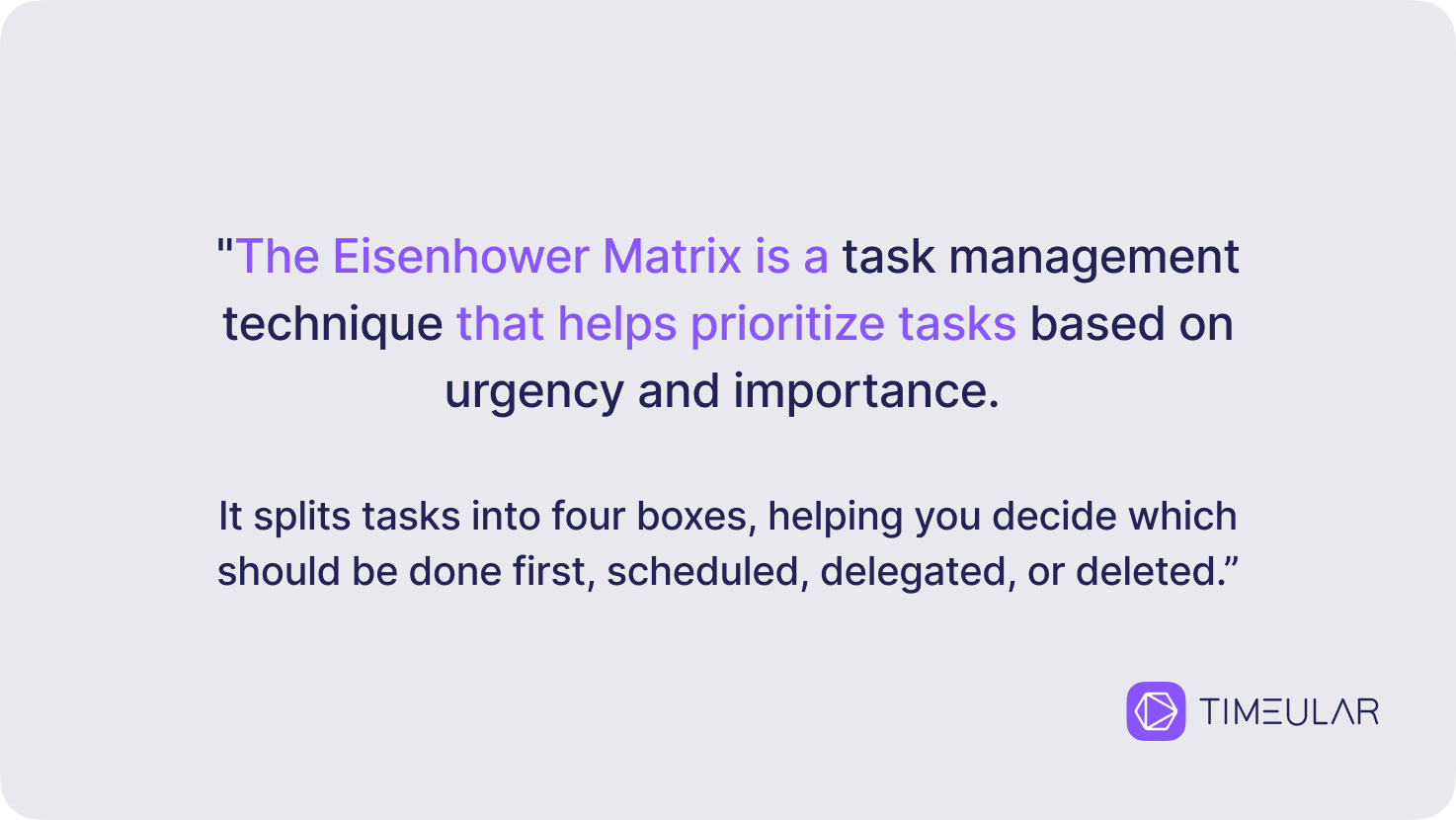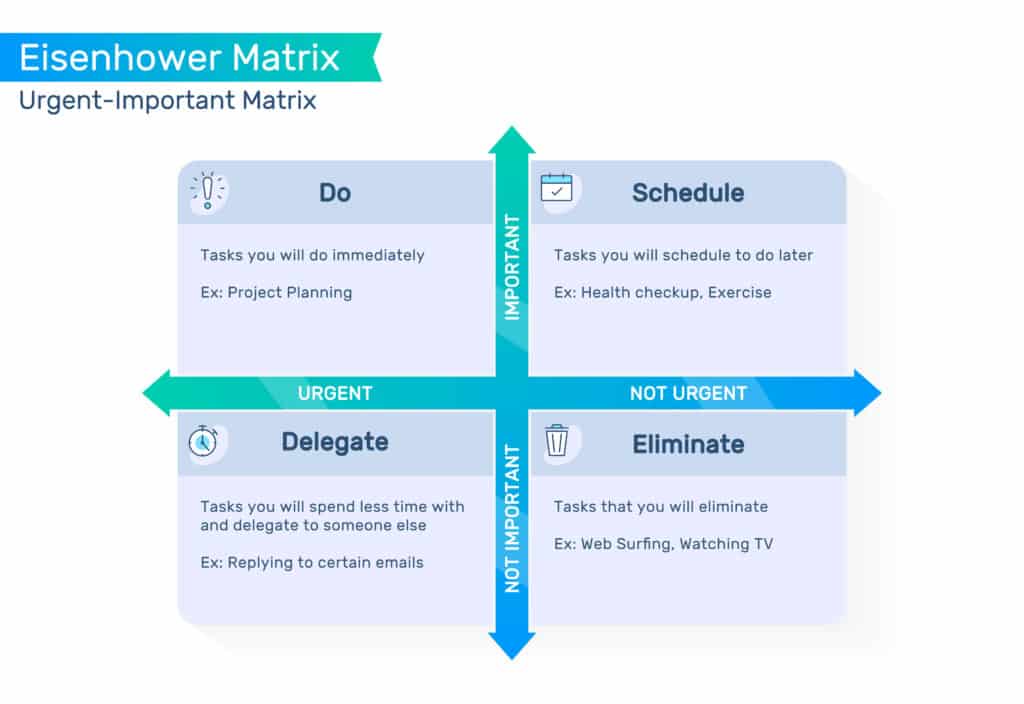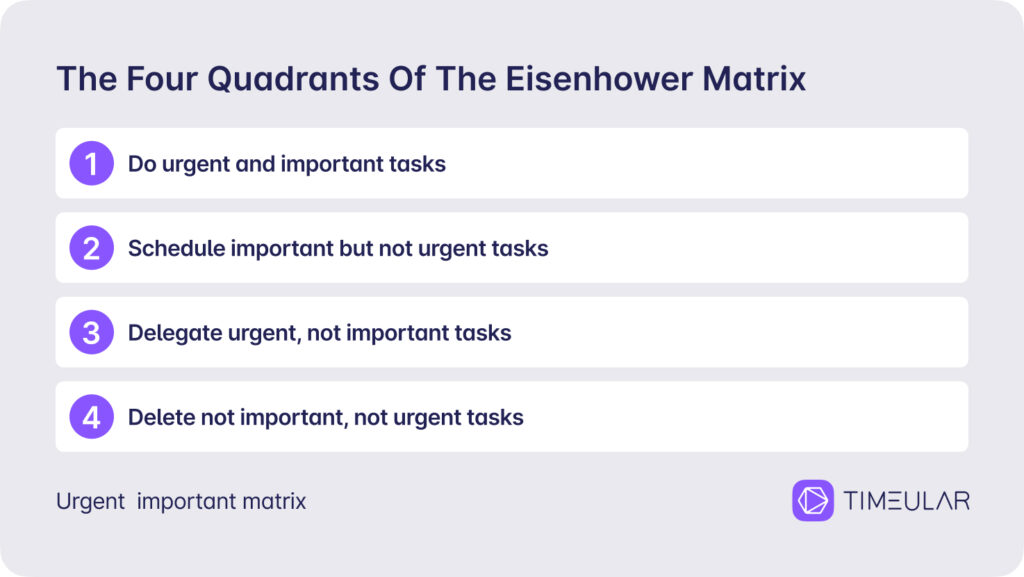The 4 Quadrants of Time Management Matrix [Guide]
When your to-do list seems endless and unstructured, you don’t even know what to start with unless you have a strategy that determines how you prioritize tasks.
So, all you need is a way to declutter your list from unnecessary tasks, but focus on the ones that need your immediate attention and focus.
That’s exactly what the Time Management Matrix (also called the Eisenhower Matrix) helps with—effective prioritization, productivity, and a cohesive workflow. Let’s dive in.
What is the Time Management Matrix?
The Time Management Matrix is one of the best prioritization techniques, which helps you organize tasks by urgency and importance. Though popularized and shaped by Stephen Covey in his productivity book “The 7 Habits of Highly Effective People”, it was first introduced by the President of the United States, Dwight Eisenhower, in 1954.

The 34th President of the US, who was also a five-star general during World War II, cited an unnamed university president saying: “I have two kinds of problems, the urgent and the important. The urgent are not important, and the important are never urgent.”
The President used the Eisenhower matrix to prioritize and deal with the many high-stakes issues he faced as a US Army general and then as Supreme Allied Commander of NATO Forces. Nowadays, this self-management tool is widely used by businesses and individuals to prioritize tasks and identify time wasters.
Now, let’s get into the actual Four Quadrants of Time Management, what they mean, and how it all works.
The Covey’s 4 quadrants of the Time Management Matrix

As you can see above, the Eisenhower matrix assigns urgent and important tasks to a quadrant. Once the task list is mapped into the four categories, one can allocate time wisely to achieve the desired outcomes.
The quadrants are as follows:
Quadrant 1 (Do) = Urgent and important tasks
Quadrant 2 (Schedule) = Not urgent, yet important tasks
Quadrant 3 (Delegate) = Important but not urgent tasks
Quadrant 4 (Delete) = Not urgent and not important tasks
The goal of using this matrix is to improve both your personal and professional life and promote growth and accomplishment.

What’s the difference between urgent and important tasks?
Urgent and important tasks seem fairly similar, but based on the Eisenhower principle, they’re not. But let’s start by understanding the basics of the Eisenhower matrix first.
Urgent tasks require immediate action, and the timeframe for doing them is either now or ASAP. If they’re not completed by the deadline, they can have significant repercussions and cause high levels of stress due to their time-sensitive nature.
Examples of urgent tasks can be:
Handling a PR issue that impacts your brand reputation.
Making changes to a client marketing campaign as it’s yielding unexpected, negative results.
Important tasks contribute to long-term goals ( aka big rocks) and represent the foundation for other projects. In their absence, you’d not be able to manage your other finalizing tasks or have sustained progress. Even if they’re not urgent, important tasks have a lasting impact both professionally and on your well-being.
Examples of important tasks can be:
Conducting an analysis of past campaigns to identify what worked well and what can be improved in the next campaign.
Doing market research to understand target audiences, competitors, or market trends.
Note: the above tasks are mentioned from a marketer’s perspective, but I’m convinced these can be applied to your particular case or role.

1 – Do urgent, important tasks
The first quadrant comprises both urgent and important tasks and requires immediate action. So there’s no choice but to do these urgent matters. If these important and time-sensitive tasks are not finalized as soon as possible, they have clear consequences and affect long-term goals.
By reverse engineering, you can take these two traits (consequences and goals) to decide what tasks should go in the first quadrant.
A way to imagine a task that falls into this category is unforeseen events that require you to drop your responsibilities and focus on resolving urgent issues. Even though it’s super stressful, many people can spend their whole lives in this Quadrant, letting life problems take control. Spending too much time in this Quadrant will not allow you to grow much.
2 – Schedule important, not urgent tasks
The second Quadrant is not as urgent as the first one, but the tasks are just as important. Essentially, they’re important but not urgent. So, as you’re not dealing with pressing problems, you have the freedom to take a breather before you schedule time to perform these tasks.
Remember, the red thread of this quadrant is scheduling time. It allows you to perform an important task more effectively and productively at a chosen time. So you’ll be more in control of your task management and to-do list.
- Recommended read: What is a DuPont schedule?
3 – Delegate urgent, not important tasks
In this third Quadrant, you’ll find the less critical tasks. All those urgent tasks that come to you only to take off your quality work time. It can be meetings, phone calls, e-mails, or interruptions that might disrupt your work. Therefore, since we might not have enough time to focus on these tasks and not a specific skill set, here comes the concept of delegating tasks.
Ultimately, you want to spend as little time as possible on this Quadrant. The time spent on these tasks is often counterproductive and doesn’t contribute much to your work, goals, and productivity.
It’s particularly beneficial to delegate many tasks from this category to your team as a project manager
4 – Delete not important, not urgent tasks
This last quadrant leaves you with a handful of tasks that are not urgent and not important tasks. As you spend more and more time here, all your energy gets sucked, and you can end up in procrastination activities such as checking social media and watching tv.
It’s easy for our brains to spend more time here as it doesn’t require any mental capacity and will just make you avoid more important tasks during the day. So, deleting these tasks from your to-do lists is pivotal.

Create your own Time Management Matrix
Let’s assume you own a small marketing agency. I’ve ideated on some tasks that you might deal with on a daily basis. Explore how the Eisenhower matrix applies these tasks.
Examples of tasks in the Do first quadrant (important tasks, urgent tasks):
A major client’s threatening email to look for another agency if you’re not solving their maintenance projects ASAP;
Final approvals for a major campaign launch for your biggest client;
Your team needs approval for a major expense in the context of cash flow issues.
Examples of tasks in the Schedule quadrant (important but not urgent tasks):
Regular calls with your top clients to discuss their long-term goals;
Carry interviews for a COO;
Create and write the agency’s long-term strategy;
Examples of tasks in the Delegate quadrant (urgent but not important tasks):
Keeping the meeting notes in a client call;
Social media updates or routine content publishing on the website.
Examples of tasks in the Delegate quadrant
Low-impact emails sent internally;
Negotiations with less critical vendors.

Manage your own Eisenhower matrix
Okay, the urgent, important matrix is done, but how do I manage this matrix, and how do I even start? Here are some ways to manage the process:
1. Start small by writing down all your tasks
Start doing a task brain dump in a digital or a physical notebook. This will help with getting your tasks out of your head, removing the mental pressure, and helping objectively identify afterwards the urgency and importance.
It’s ideal to start with your daily tasks first, followed by weekly and monthly tasks to have the first ones you’d need to take in front of you.
Jot down all tasks without any other filter. Add important deadlines, meetings, calls, e-mails, and client complaints to deal with. Hopefully, by the end of this exercise, you’ll get a clear picture of your workload, and you’ll already feel less overwhelmed.
2. Color label your tasks based on deadlines
To-do lists seem like endless piles, but by simply adding color to each item, you’re already adding some priority to them. Your color codes could be:
Red = First deadline to hit
Brown = Second deadline in line
Blue = Third deadline
Yellow = Last deadline
As you’ve assigned the colors and priorities in some capacity, you’ll be able to integrate these tasks directly into the Eisenhower matrix, as you already have the urgent ones.
3. Keep it manageable
Even if everything seems important and urgent, I can guarantee they’re not. It’s best to identify a number of tasks that you’re adding to your Eisenhower matrix, as it’s easier to navigate it and keep it decluttered and actionable.
A number between 7-12 tasks could be reasonable to keep inside your matrice, and once you’ve finalized some of them, you could create another one.
4. Be mindful of the separation of personal and professional tasks
We all have the tendency to mix professional with personal lives, but it’s not best. Your personal daily to-do list deserves a separate matrice, though. The Eisenhower matrix helps you get rid of excessive TV or playing games too much, but it’s not a clear separation between work and personal life, which can have ripple effects. On that note, I’d put those two activities in the delete quadrant.
You might be interested in Time management tools, too.
5. Say no to unnecessary work
Use the Eisenhower matrix as an opportunity to learn how to say no at work – when you notice how much unnecessary it’s granted to you, start delegating tasks to others. Don’t lock yourself in a hectic routine to consume energy on less important work. Prioritize the work that yields the highest impact on your long-term goals.
Track time automatically or manually, with a physical time tracker or keyboard shortcuts. Under 1 minute a day.
You’re ready for practice
By now, you should be equipped with an essential framework to get things done. The 4 Quadrants of the Time Matrix will be a great aid in improving your performance, organizing your tasks and prioritizing them, managing multiple projects or spending less time on useless things, and focusing on what matters.
If you want to be a step ahead, combining 4 quadrants with a time-tracking tool to manage time better might bring long-term payoffs.
FAQ
What are the 4 categories of time management?
The 4 categories of time management are:
Do = Urgent and important tasks.
Schedule = Not urgent, yet important tasks.
Delegate = Important but not urgent tasks.
Delete = Not urgent and not important tasks.
What are the 4 D’s of effective time management?
The 4 D’s of Time Management are: Do, where you do tasks immediately because they’re urgent and important; Delegate, where you assign tasks to others so you can focus on more critical tasks; Defer, where you put tasks off until later when they become more relevant or manageable; and Delete, where you get rid of tasks that don’t contribute to your goals or productivity.
What are the 4 P’s of time management?
The 4 P’s of Time Management are key to being productive: Prioritize, where you rank tasks to determine their importance and urgency; Plan, where you organize tasks and schedule them; Perform, where you execute tasks as planned; and Perfect, where you refine processes to get better and better.
What are 4 time management skills you should have?
There are far more than 4 time management skills worth polishing, but for starters, focus on time tracking, planning your goals, prioritizing, and learning how to say no.